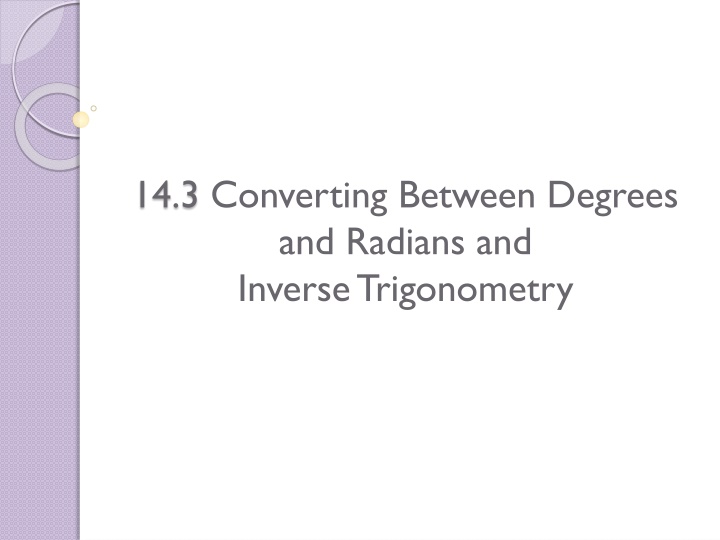
Converting Between Degrees and Radians in Trigonometry
Learn how to convert angle measures between degrees and radians, evaluate trigonometric functions for angles larger than a full circle, and sketch angles in standard form. Discover the relationships between degrees and radians and how to work backwards to find angle values on the unit circle.
Download Presentation

Please find below an Image/Link to download the presentation.
The content on the website is provided AS IS for your information and personal use only. It may not be sold, licensed, or shared on other websites without obtaining consent from the author. If you encounter any issues during the download, it is possible that the publisher has removed the file from their server.
You are allowed to download the files provided on this website for personal or commercial use, subject to the condition that they are used lawfully. All files are the property of their respective owners.
The content on the website is provided AS IS for your information and personal use only. It may not be sold, licensed, or shared on other websites without obtaining consent from the author.
E N D
Presentation Transcript
14.3 Converting Between Degrees and Radians and Inverse Trigonometry
Converting Between Degrees and Radians When we convert between degrees and radians we multiply by a . 1 The easiest value that is equivalent is radians and degrees. 180 So, to convert from degrees to radians we multiply by 180 . And to convert from radians to degrees we multiply by 180 .
Convert each angle measure from degrees to radians. =120o 1. = 30o 2. o = 410 3.
Convert each angle measure from radians to degrees. Round to the nearest tenth. =7 6 4. = 5. 3 =5 6. 2
Revolutions Greater than a Full Circle The unit circle continues to revolve past a full circle in both the positive and the negative direction. An is determined by rotating a ray about its vertex. The the ray extending from the vertex before rotation. The resulting ray, after the rotation, is called the terminal angle side initial of an angle is side . When the initial side coincides with the positive x-axis and the vertex is at the origin, it is said to be in standard . position
In order to evaluate trig functions of angles larger than one revolution, it is helpful to determine where on the unit circle the value lies by working backwards. To find that value, you can subtract a full circle until you get a value that is on the first revolution.
Sketch the angle in standard form and evaluate the trig function. sin 570o ( ) cos495o 7. 8.
Sketch the angle in standard form and evaluate the trig function. sin9 cos 19 9. 6 10. 4
Sometimes you will be given the value of the trigonometric function and you will need to work backwards to find the point on the unit circle that corresponds to that value. Typically you will be looking at one revolution of the unit circle so between 0 and in radians and between 0 and 360 in degrees.
0 2 Find such that . 3 11. sin = 2 3 Is positive or negative? 2 In which quadrant(s) is the sin value positive? What real number, , has a y-coordinate of ? 2 3
0 2 Find such that ( sec . ) 1 2 12. Positive or negative? What quadrant(s) is secant negative in? 2 What is the reciprocal of ? What real number, , has an x-coordinate of ? 2 2
Find such that . 0o 360o 3 13. tan arc 3 Positive or negative? What quadrant(s) is tangent positive in? 3 Where is tangent equal to ? 3
Find such that . 0o 360o = csc undefined 14. Positive or negative? What does this mean about sin? Where is sin = 0?
Use the unit circle below to help remember when each trig function is positive.
0 2 1 1 sin Find such that . cot = 3 15. 16. 2 2 3 3 2 = cos arc 17. 18. csc 2
Find such that . 0o 360o 3 3 1 cos = 19. 20. sin 2 2 ( ) 1 sin = 0 1 cot 21. 22.
Evaluate. ( ) 5 1 sin cos180 1 cos cos 23. 24. 4 5 ( ) 1 25. 26. 1 sin cos tan tan135 3
